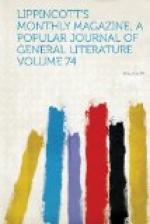Were I to seek a “funny man” among the quadrupeds, I should name another dweller of the Southwestern prairies, the jack-rabbit,—John II. let us call him. Nobody ever gets quite accustomed to the preternatural ears of this hare. In proportion they are to those of others of the Leporidae nearly what the ears of the mule are to those of the horse. When this bit of bad drawing, as big as a fawn and weighing ten pounds or so, jumps up before you and bounds away at railroad speed, he makes you rub your eyes. You expect the apparition to disappear like other apparitions, especially as it moves off with vast rapidity. But it does not. As suddenly as it started it is transformed into a prong like an immense letter V, projecting in perfect stillness from the grass a hundred yards off. You advance, and the same proceeding is repeated. Jack is obviously deep in guns, and knows the difference in power between a muzzle- and a breech-loader, if he has not ascertained, indeed, what number shot you have in your cartridge. He varies his distance according to these contingencies. Only, he has not as yet learned to gauge the greyhound: that dog is frequently kept for his benefit.
A special endowment of this immediate locality is a large and permanent sheet of water, three or four miles by one, which bears, and deserves, the name of Eagle Lake. For, though overhung by no cliffs or lofty pines, it is far more the haunt of eagles, of both the bald and the gray species, than most tarns possessing those appendages of the romantic. Its dense fringe of fine trees, among them live-oaks a single one of which would make the fortune of an average city park, can well spare the Conifers. They are all hung with Spanish moss, a feature which conflicts with the impression of lack of moisture conveyed by the light ashen color of the bark and short annual growth of many of the smaller trees. Here and there tiny inlets are overhung with undergrowth which supplies a safe nesting-place to a multitude of birds of many kinds. The surface of the lake I have never seen free from ducks of one species or another, and generally of half a dozen. Almost the whole family, if we except the canvas-back and the red-head, visit it at one or another period. One item in their bill of fare is the nut of the water-lily, the receptacles of which, resembling the rose of a watering-pot, dot the shallows in great quantity. The green, cable-like roots of this plant are afloat, forming at some points heavy windrows. Some say they are torn up from the bottom by the alligators; but it is more probable that they are loosened and broken by the continual tugging of the divers. The alligators are not vegetarians, and they are not using their snouts much at this season. The young shoots of the Nymphaea are doubtless tempting food, as those of the Vallisneria are on the Chesapeake and the North Carolina sounds. Sustenance may be drawn also from the roots of the rushes and reeds which cover with their yellow stems and leaves many acres of the lake, and are thronged now by several species of small birds.




